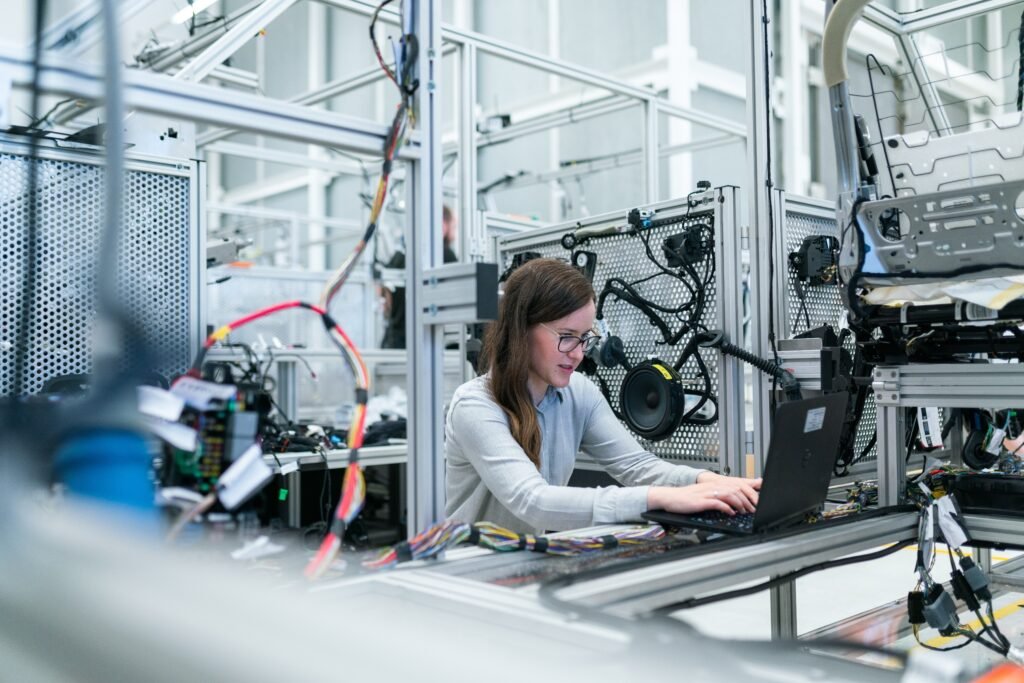Imagine a world where machines possess the power to think and reason, where they can learn and adapt just like human beings. This extraordinary concept has become a reality with the invention of Artificial Intelligence (AI). With AI, machines can now perform tasks that were once limited to human intelligence, revolutionizing various industries and transforming the way we live. In this article, we will explore the journey of how AI came to be, its impact on society, and the endless possibilities it holds for the future.

The Origins of Artificial Intelligence
The Birth of Computer Science
The origins of artificial intelligence can be traced back to the birth of computer science. In the early 1940s, the world witnessed the emergence of the first electronic computers. These machines were not only capable of solving complex mathematical calculations but also opened up new possibilities for human-machine interaction. With the invention of the computer, scientists and researchers began to dream of creating machines that could mimic human intelligence.
The Concept of Artificial Intelligence
Artificial intelligence, commonly known as AI, refers to the development of computer systems that can perform tasks that would typically require human intelligence. The concept of AI revolves around creating machines capable of reasoning, problem-solving, learning, and decision-making in a manner similar to human beings. AI systems can process vast amounts of data, learn from patterns, and adapt their actions to changing circumstances.
The Early Pioneers of AI
The foundation of artificial intelligence was laid by a group of visionaries who saw the potential for machines to exhibit intelligent behavior. Some of the early pioneers of AI include Alan Turing, John McCarthy, and Marvin Minsky. These individuals, driven by curiosity and a desire to push the boundaries of computer science, paved the way for the development of AI as we know it today.
The Early Stages of AI Development
The Dartmouth Conference
In the summer of 1956, the Dartmouth Conference marked a significant milestone in the history of AI. It was at this conference, organized by John McCarthy and Marvin Minsky, that the term “artificial intelligence” was coined. The conference brought together a group of researchers who were enthusiastic about exploring the possibilities of creating intelligent machines. The discussions and collaborations that took place at Dartmouth set the stage for further advancements in the field.
The Development of Early AI Programs
Following the Dartmouth Conference, researchers began to develop early AI programs. These programs aimed to demonstrate the potential of machines to exhibit intelligent behavior. One notable example of early AI program development was the Logic Theorist, created by Allen Newell and Herbert A. Simon in 1955. The Logic Theorist was capable of solving mathematical problems using logical reasoning, demonstrating that machines could perform tasks traditionally associated with human intelligence.
The Turing Test
Another significant event in the early stages of AI development was the proposal of the Turing Test by Alan Turing in 1950. The Turing Test posed the question of whether a machine could exhibit intelligent behavior indistinguishable from that of a human. According to the test, if a human evaluator could not tell whether a response came from a human or a machine, the machine could be considered to possess artificial intelligence. The Turing Test sparked further research into creating machines that could pass this test, leading to the development of more sophisticated AI systems.
The First AI Breakthroughs
The Logic Theorist
The Logic Theorist, created by Newell and Simon, was a significant breakthrough in the early years of AI. It demonstrated the ability of a machine to solve complex mathematical problems by applying logical reasoning. The Logic Theorist successfully proved several mathematical theorems, showcasing the potential of AI to automate intricate problem-solving tasks.
The General Problem Solver
Building on the success of the Logic Theorist, Newell and Simon developed the General Problem Solver (GPS). The GPS was an AI program designed to solve a wide range of problems using heuristic search techniques. By representing problems and solutions in a logical framework, the GPS could find optimal or near-optimal solutions for various real-world scenarios. This groundbreaking development opened up possibilities for AI to tackle complex, real-life problems.
The Creation of Expert Systems
In the 1970s and 1980s, AI researchers started developing expert systems. These systems were designed to mimic the decision-making abilities of human experts in specific domains. Expert systems utilized knowledge-based rules and inference engines to reason through complex problems and provide expert-level advice. This breakthrough in AI allowed machines to excel in specific areas, such as medical diagnosis and financial analysis, by leveraging the expertise and knowledge of human professionals.
Machine Learning: A Milestone in AI
The Concept of Machine Learning
Machine learning emerged as a milestone in AI, focusing on enabling computers to learn from data and improve their performance without being explicitly programmed. This field of study revolves around the development of algorithms that can analyze vast amounts of data, recognize patterns, and make predictions or decisions based on these patterns. Machine learning algorithms can automatically adjust their behavior, improving their accuracy over time as they encounter more data.
The Development of Neural Networks
Neural networks, inspired by the structure and functioning of the human brain, played a crucial role in the advancement of machine learning. Neural networks consist of interconnected nodes, or neurons, that process and transmit information. They can be trained to recognize patterns by adjusting the strength of connections between neurons based on the input data. The development of neural networks enabled machines to learn complex patterns and perform tasks such as image recognition and natural language processing.
The Application of Machine Learning in Industry
With the advancements in machine learning, AI found its way into various industries. Machine learning algorithms are now commonly used in fields like finance, healthcare, marketing, and entertainment. For example, in finance, machine learning algorithms analyze market data to identify patterns and make predictions for investment strategies. In healthcare, machine learning powers diagnostic tools that can detect diseases earlier and improve patient outcomes. The application of machine learning has revolutionized many sectors, driving efficiency and innovation.

Symbolic AI and Knowledge Representation
The Introduction of Symbolic AI
In the 1960s, symbolic AI emerged as a prominent approach to AI, focusing on manipulating symbols and rules to mimic human cognition. Symbolic AI systems represent knowledge using logical symbols and employ logical reasoning to derive conclusions. These systems operate on explicit representations of concepts, allowing for explicit reasoning and decision-making. The introduction of symbolic AI paved the way for the development of expert systems and knowledge representation systems.
The Development of Knowledge Representation Systems
Knowledge representation systems are integral to AI, as they allow machines to understand, store, and manipulate knowledge. In the early years of AI, researchers developed various knowledge representation systems, such as semantic networks and frames, to represent and organize knowledge in a structured manner. These systems enabled machines to reason and make inferences based on explicit knowledge representations, contributing to the advancement of AI capabilities.
The Limitations of Symbolic AI
While symbolic AI made significant contributions to the field, it also had its limitations. Symbolic AI systems often struggled with uncertainty, ambiguity, and the ability to handle large-scale data. The rigidity of logical rules limited their ability to adapt to new situations or handle incomplete information. These limitations led AI researchers to explore alternative approaches, such as machine learning, to overcome the shortcomings of symbolic AI.
Expert Systems and Rule-Based AI
The Rise of Expert Systems
In the 1980s, expert systems became increasingly popular as a practical application of AI. Expert systems leveraged the knowledge and expertise of human specialists to provide intelligent solutions in specific domains. These systems utilized rule-based AI, where a set of rules and knowledge representation were used to guide decision-making. Expert systems found success in various areas, including medicine, where they could assist in diagnosing diseases, and finance, where they could provide investment advice based on expert knowledge.
The Use of Rule-Based AI Systems
Rule-based AI systems played a crucial role in the development of expert systems. These systems utilized a set of rules, often in the form of “if-then” statements, to represent knowledge and guide decision-making processes. By applying these rules to specific situations or inputs, rule-based AI systems could generate appropriate responses or actions. This approach allowed machines to mimic the decision-making abilities of human experts in a particular domain.
The Limitations and Challenges of Expert Systems
While expert systems showcased the capabilities of AI in specific domains, they also faced limitations and challenges. Expert systems heavily relied on human experts to provide the initial knowledge and rules, making them dependent on the availability and expertise of these professionals. The complexity of capturing expert knowledge in a comprehensive rule-based system often posed challenges, and these systems struggled to handle uncertainty and context-dependent situations. To overcome these limitations, AI researchers continued to explore new approaches, such as machine learning and neural networks.

Natural Language Processing and Speech Recognition
The Development of Early Natural Language Processing
Natural Language Processing (NLP) deals with the interaction between computers and human language. In the early stages of AI, researchers began developing NLP techniques to enable machines to understand and generate human language. These techniques involved parsing sentences, extracting meaning from text, and building systems capable of responding to natural language inputs. Early NLP laid the foundation for advancements in communication between humans and machines.
The Advent of Speech Recognition Technology
Speech recognition, a branch of NLP, focuses on enabling machines to understand spoken language. The development of speech recognition technology was a significant breakthrough in AI, allowing machines to process and interpret human speech. Through the use of machine learning algorithms and statistical models, computers could recognize and transcribe spoken words, enabling voice-controlled applications and systems. Speech recognition technology has transformed industries such as customer service, voice assistants, and accessibility for people with disabilities.
The Impact of NLP on Various Industries
NLP has had a profound impact on various industries, revolutionizing the way humans interact with machines. In customer service, NLP-powered chatbots can handle customer inquiries and provide support 24/7, improving response times and customer satisfaction. In healthcare, NLP enables the analysis of medical records and documents, assisting doctors in making timely and accurate diagnoses. NLP also plays a crucial role in sentiment analysis, enabling businesses to understand customer feedback and tailor their products and services accordingly. The applications of NLP continue to expand across industries, enhancing human-machine communication and efficiency.
Computer Vision and Image Recognition
The Early Days of Computer Vision
Computer vision is an interdisciplinary field that aims to enable machines to interpret and understand visual information from images and videos. In the early days of AI, researchers began exploring computer vision techniques to mimic human visual perception. These techniques involved image processing, pattern recognition, and feature extraction, allowing machines to analyze and interpret visual data. The development of computer vision opened up possibilities for machines to understand the visual world, leading to advancements in image recognition and object detection.
The Development of Image Recognition Algorithms
Image recognition is a subfield of computer vision that focuses on enabling machines to recognize and classify objects or patterns within images. Over the years, researchers have developed sophisticated image recognition algorithms, leveraging machine learning and deep learning techniques. These algorithms can analyze image features, learn from large datasets, and accurately identify objects in real-time. Image recognition applications are now widespread, ranging from facial recognition in security systems to self-driving cars’ object detection capabilities.
The Practical Applications of Computer Vision
Computer vision has found practical applications in various industries, transforming sectors such as healthcare, automotive, and retail. In healthcare, computer vision enables the analysis of medical images, aiding in the early detection of diseases and assisting doctors in treatment planning. In automotive industries, computer vision powers advanced driver-assistance systems that can detect pedestrians, traffic signs, and lane markings, enhancing road safety. In retail, computer vision enables automated checkout processes and inventory management systems. The practical applications of computer vision continue to grow, revolutionizing industries and improving efficiency.
Deep Learning and Neural Networks
The Emergence of Deep Learning
Deep learning emerged as a subset of machine learning, focusing on training artificial neural networks with multiple layers. This approach allows computers to learn hierarchical representations of data, mimicking the structure of the human brain. Deep learning algorithms excel in tasks that require the analysis of complex and unstructured data, such as images, text, and voice. The emergence of deep learning revolutionized AI, enabling breakthroughs in areas such as image recognition, natural language processing, and autonomous vehicles.
The Role of Neural Networks in AI
Neural networks, at the core of deep learning, play a critical role in advancing AI capabilities. These interconnected networks of artificial neurons can learn from vast amounts of data, find patterns, and make predictions. The ability of neural networks to simulate human-like learning and decision-making processes has led to significant advancements in AI disciplines such as computer vision, speech recognition, and recommendation systems. Neural networks have become a powerful tool in developing intelligent machines that can perform complex tasks with high accuracy.
The Breakthroughs in Deep Learning Applications
Deep learning has achieved remarkable breakthroughs in various AI applications. In computer vision, deep learning algorithms have surpassed human performance in tasks such as image classification and object detection. In natural language processing, deep learning has enabled machines to understand context, generate human-like responses, and even translate languages in real-time. Deep learning has also paved the way for advancements in autonomous vehicles, robotics, and personalized recommendation systems. These breakthroughs have pushed the boundaries of AI and brought it into our everyday lives.
Recent Advances in AI
The Rise of AI in Everyday Life
Over the past decade, AI has become increasingly integrated into our everyday lives. AI-powered technologies and applications are now ubiquitous, from voice assistants on our smartphones to personalized recommendations on streaming platforms. AI algorithms are used in social media to curate news feeds and targeted advertising. Industries such as healthcare, finance, and transportation leverage AI to improve efficiency, accuracy, and decision-making. The rise of AI has transformed the way we work, communicate, and interact with technology.
Ethical Concerns with AI
As AI continues to advance, there are growing concerns about its ethical implications. Issues such as bias in AI algorithms, privacy concerns, and the impact of automation on jobs have come to the forefront. AI algorithms can unintentionally inherit biases present in training data, leading to discriminatory outcomes. The collection and use of personal data by AI systems raise questions about privacy and data security. Ethical considerations and responsible development practices are crucial to ensure that AI benefits society as a whole.
The Future of Artificial Intelligence
The future of artificial intelligence holds immense possibilities. AI is expected to continue transforming industries, driving innovation, and improving efficiency. The integration of AI with other emerging technologies such as robotics, internet of things (IoT), and quantum computing will open up new frontiers for AI applications. Advances in explainable AI and AI safety research will address concerns regarding transparency and trustworthiness. The development of AI systems that can collaborate and communicate with humans seamlessly will further enhance human-machine interaction. With ongoing research and advancements, the future of artificial intelligence promises exciting opportunities for shaping a better tomorrow.
In conclusion, the origins of artificial intelligence can be traced back to the birth of computer science and the visionary pioneers who saw the potential of machines to exhibit intelligent behavior. From early AI programs and expert systems to the breakthroughs in machine learning, natural language processing, and computer vision, AI has evolved rapidly over the years. The recent advancements have brought AI into our everyday lives, raising ethical concerns and shaping the future of this rapidly evolving field. As we look ahead, artificial intelligence is poised to revolutionize industries, transform society, and continue pushing the boundaries of human innovation.






